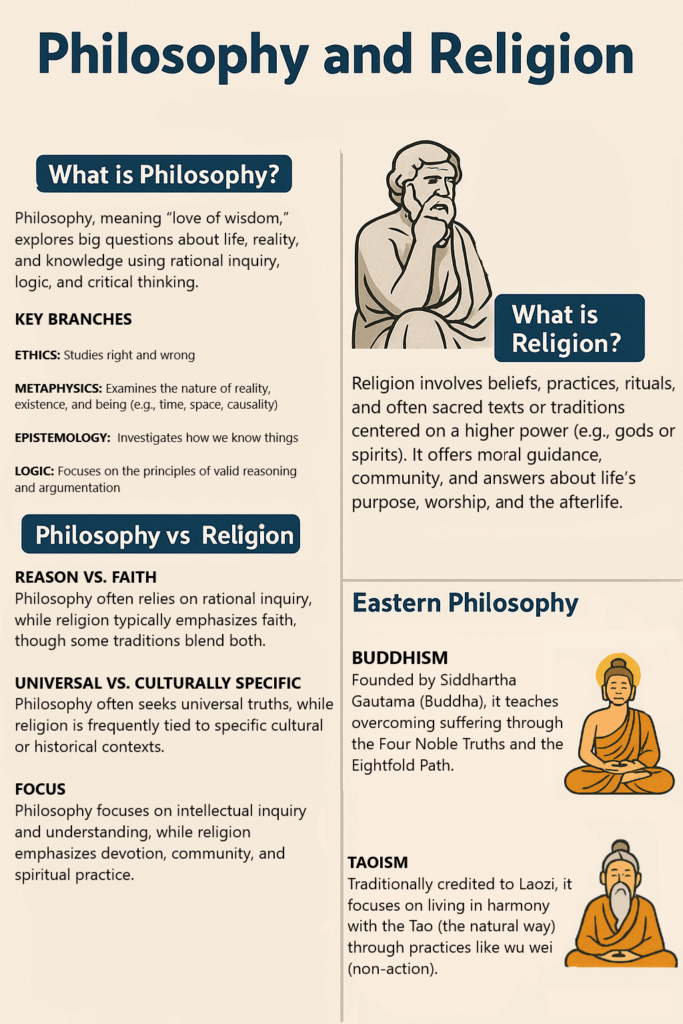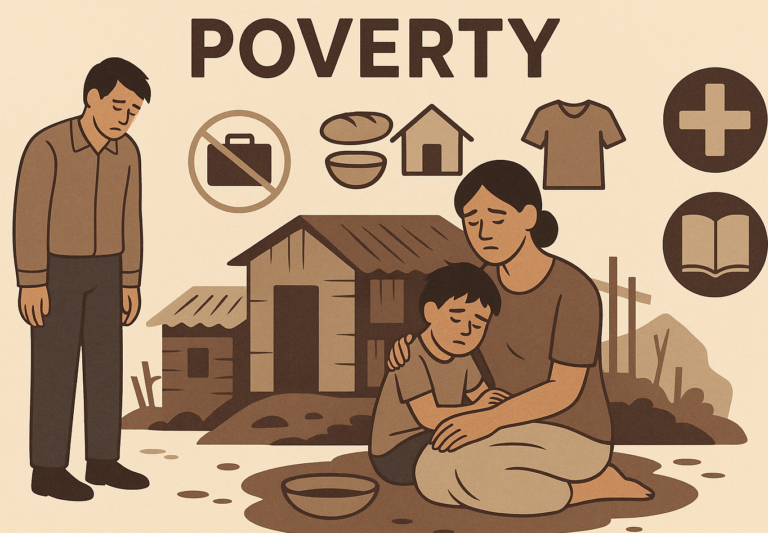Philosophy and Religion: An Easy Guide to Understanding
Philosophy and religion are two important areas of human thought that have shaped cultures, societies, and individuals for thousands of years. While they are related, they differ in their approaches and purposes. Here’s a simple way to understand both.

What is Philosophy?
Philosophy comes from the Greek words philos (meaning “love”) and sophia (meaning “wisdom”), so it literally means “the love of wisdom.” Philosophy is the study of fundamental questions about life, existence, knowledge, reason, and ethics. Philosophers ask big questions like:
- What is the meaning of life?
- What is right and wrong?
- How do we know what we know?
- What is real and what is just an illusion?
Philosophers seek to understand the world and our place in it by using reasoning, logic, and critical thinking. They explore concepts like ethics (what is good and bad), metaphysics (what exists and why), and epistemology (how we gain knowledge). Some of the most famous philosophers include Socrates, Plato, Aristotle, Immanuel Kant, and René Descartes.
Key Branches of Philosophy:
- Ethics: The study of what is good and bad, and how people should behave.
- Metaphysics: The study of what exists and the nature of reality.
- Epistemology: The study of knowledge—how we know what we know.
- Logic: The study of reasoning and argumentation.
What is Religion?
Religion is a system of beliefs, practices, and rituals centered around the worship of a higher power or powers, often in the form of gods, spirits, or a supreme being. Religion deals with questions about life’s purpose, the nature of the divine, and morality. Unlike philosophy, which is based on reasoning and debate, religion often involves faith and spiritual experience.
Religions provide people with a set of guidelines for how to live a moral life, offer answers to questions about the afterlife, and help build a sense of community. Different religions have different practices, sacred texts, and beliefs, but most share a common focus on helping people find meaning and purpose in life.
Some of the world’s major religions include:
- Christianity: Based on the life and teachings of Jesus Christ.
- Islam: Based on the teachings of the prophet Muhammad and the Quran.
- Hinduism: An ancient religion that focuses on the concept of dharma (duty) and moksha (liberation).
- Judaism: The religion of the Jewish people, based on the Hebrew Bible (Old Testament).
- Buddhism: Focuses on enlightenment through the elimination of suffering.
Differences Between Philosophy and Religion
- Reason vs. Faith: Philosophy relies on reason and logical thinking to answer questions, while religion often involves faith and spiritual belief in the unseen or divine.
- Universal vs. Specific: Philosophy tends to be universal, applying to everyone regardless of their religion or culture. Religion, on the other hand, often has specific beliefs and practices tied to particular cultures or communities.
- Focus: Philosophy seeks to understand the nature of existence, truth, and knowledge, while religion often focuses on the spiritual aspect of life, offering answers about the afterlife, the nature of God, and moral guidance.
Eastern Philosophy: An Introduction
Eastern philosophy refers to the philosophical traditions that developed in Asia, particularly in countries like India, China, Japan, and Tibet. Two of the most important traditions in Eastern philosophy are Buddhism and Taoism. While they are different in many ways, both philosophies aim to help individuals understand themselves and their relationship to the world around them.
1. Buddhism: The Path to Enlightenment
Buddhism was founded by Siddhartha Gautama (also known as Buddha) in the 5th to 4th century BCE in India. Buddha was a prince who became enlightened after meditating under a tree and understanding the nature of suffering and how to overcome it.
Key Concepts in Buddhism:
- The Four Noble Truths: These truths outline the nature of suffering and how to end it.
- Suffering (Dukkha): Life involves suffering, such as pain, illness, and death.
- The Cause of Suffering (Samudaya): The cause of suffering is desire or attachment.
- The End of Suffering (Nirodha): It’s possible to end suffering by eliminating desire.
- The Path to the End of Suffering (Magga): The way to end suffering is by following the Eightfold Path, which includes right understanding, right speech, right action, right mindfulness, and so on.
- Nirvana: The ultimate goal of Buddhism is to reach nirvana, a state of perfect peace and liberation from the cycle of birth, death, and rebirth (samsara).
- Meditation: Meditation is a central practice in Buddhism. Through mindfulness and meditation, Buddhists seek to attain inner peace and understand the true nature of reality.
Core Beliefs:
- Impermanence (Anicca): Everything in life is constantly changing.
- Non-Self (Anatta): There is no permanent, unchanging self. What we consider “self” is just a collection of changing phenomena.
- Compassion (Karuna): Compassion for all living beings is essential in Buddhism.
2. Taoism: The Way of Nature
Taoism (or Daoism) is a Chinese philosophy founded by Laozi (Lao Tzu), a wise sage, around the 6th century BCE. Taoism emphasizes living in harmony with the Tao (pronounced “dow”), which is the natural order or the “way” of the universe.
Key Concepts in Taoism:
- The Tao (The Way): The Tao is the ultimate principle that flows through all life. It is an indescribable force that governs everything in nature, including humans, animals, and the universe.
- Wu Wei (Non-Action): Taoism teaches the principle of wu wei, which means “non-action” or “effortless action.” It suggests that one should act in harmony with the natural flow of life, not force things, and allow events to unfold as they will.
- Yin and Yang: These are the two complementary forces that exist in the world. Yin (dark, feminine, passive) and Yang (light, masculine, active) are interconnected and balance each other.
Practices in Taoism:
- Tai Chi: A practice involving slow, controlled movements that promote harmony between the body and the environment.
- Meditation: Similar to Buddhism, Taoists practice meditation to cultivate inner peace and connect with the Tao.
The Tao Te Ching:
The Tao Te Ching, written by Laozi, is one of the foundational texts of Taoism. It consists of 81 short chapters that teach the principles of living in harmony with the Tao.
Comparison of Buddhism and Taoism
- Origin: Buddhism originated in India and Taoism in China, but both philosophies aim to help individuals live a peaceful and harmonious life.
- Main Goal: In Buddhism, the goal is to achieve nirvana (freedom from suffering), while in Taoism, the goal is to live in harmony with the Tao.
- Approach to Life: Buddhism focuses on overcoming suffering through mindfulness and detachment from desires, while Taoism emphasizes flowing with the natural rhythms of life and embracing simplicity.
Conclusion: Philosophy, Religion, and Eastern Thought
Both philosophy and religion provide answers to deep questions about life, existence, and the universe, but they do so in different ways. Philosophy uses reason and critical thinking, while religion often involves faith and spiritual practices. Eastern philosophy, particularly Buddhism and Taoism, offers profound insights into how we can live peacefully and harmoniously in the world, often through meditation, mindfulness, and living in balance with nature. These traditions have shaped not only the cultures of the East but have influenced thinking all around the world.











